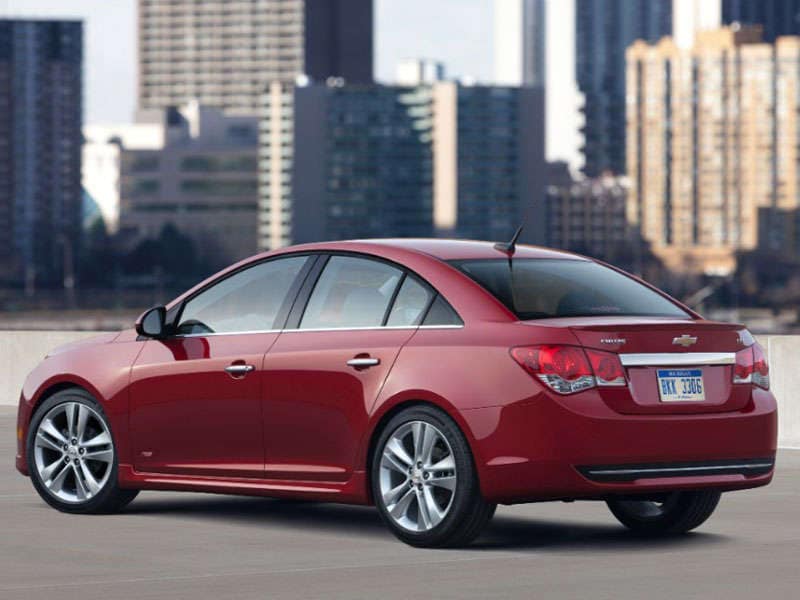Recent Articles
Popular Makes
Body Types
2014 Chevrolet Cruze Review and Quick Spin
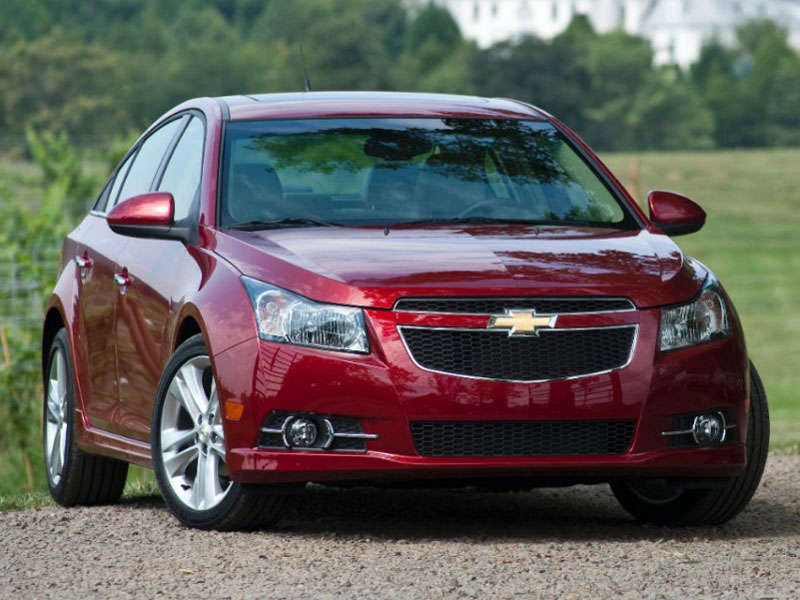
The 2014 Chevy Cruze is the best-selling car for General Motors. We’re not talking trucks or SUVs, here, we’re talking cars, and in the land of baseball, apple pie, and Chevrolet, the Cruze is king…among GM models. Within the compact sedan class in which the Cruze competes, only the Honda Civic and Toyota Corolla are more popular, an impressive feat considering that the Cruze is an older design and lacks a stamp of approval from Consumer Reports.
Does the Cruze’s popularity reflect “Buy American” sentiment in rural America, where Chevrolet has a strong network of dealers, or is the Cruze a best-seller because GM puts so many of them into government and business fleet use, such as rental car agencies, which is where I found a brand-new Cruze 2LT with fewer than 200 miles on the odometer? Either way, I figured it would be a good idea to take another look at the Cruze to determine whether it deserves more or less consideration by car buyers.
Having now covered 625 miles on the winter-ravaged roads of Massachusetts, the Cruze is better in many ways than I had expected, but suffers several flaws that keep it from rising much higher than mid-pack among affordable 4-door sedans.
2014 Chevrolet Cruze: About Our Test Car
When buying a Chevy Cruze, you choose between three different powertrains. The base version of the car is called the Cruze LS ($18,345 including a destination charge of $825), and it has an unremarkable 138-horsepower, 1.8-liter engine. At the opposite end of the price spectrum sits the Cruze Diesel ($25,810), which is the most fuel-efficient version and is equipped with a 2.0-liter 4-cylinder turbo-diesel engine that makes 151 horsepower and tons of torque.
In between these models you’ll find the Cruze 1LT ($19,640), the Cruze 2LT ($22,120), the Cruze LTZ ($24,630), and the Cruze Eco ($20,760), each of which is powered by a turbocharged, 1.4-liter 4-cylinder engine. It makes the same amount of horsepower as the Cruze LS model’s 1.8-liter engine, but the power peaks lower in the rev range, and the smaller turbocharged engine also generates more, and more accessible, amounts of torque.
In addition to a turbocharged engine, the Cruze 1LT includes 16-inch aluminum wheels, a leather-wrapped steering wheel and shift knob, cruise control, a USB port, and power exterior mirrors. The Cruze Eco is based on this version of the car, adding aerodynamic and mechanical tweaks designed to eke as many miles as possible out of each gallong of gas. The Eco model also includes lightweight 17-inch wheels, ultra-low rolling resistance tires, and a MyLink touchscreen infotainment system.
Choose the Cruze 2LT for a different 17-inch wheel design and the MyLink system, plus leather upholstery, a 6-way power driver’s seat, heated front seats, upgraded brakes, and a sport-tuned suspension. The Cruze Diesel is similarly outfitted, but with a unique wheel design and, of course, a turbo-diesel engine matched to a standard automatic transmission.
The Cruze LTZ sits at the top of the lineup in terms of equipment if not price, offered only with the 1.4-liter turbocharged engine and an automatic transmission, and equipped with automatic climate control, keyless access with push-button starting, remote engine starting, a reversing camera, chrome exterior trim, fog lights, and 18-inch wheels.
My test car was the Cruze 2LT with an optional automatic transmission, painted Summit White, equipped with a Black leather interior, and wearing a $23,405 price tag. All photos in the review show the Cruze LTZ in extra-cost Crystal Red Tintcoat paint.
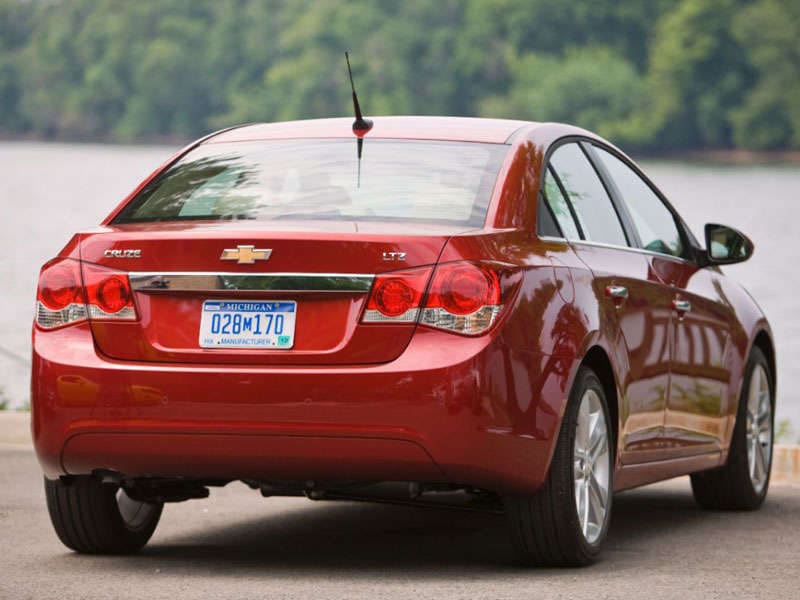
2014 Chevrolet Cruze: Styling and Design
Despite its age and ubiquity, the Chevy Cruze still looks good, and has arguably set the styling stage for all modern Chevrolet cars. I like its frowning, almost angry visage, its chiseled front end and hood, and its fastback roofline. The oversized taillights and chrome trim between them are garish, though.
The Cruze’s interior is appealing in terms of textures and tones. Hard plastic surfaces are the rule, but consistent graining and matte finishes give them a more upscale, higher quality appearance than they might otherwise deserve. Plus, nothing feels flimsy or poorly affixed to the vehicle. This is a sturdy cabin.
Add the unusual netted cloth that covers parts of the Cruze’s dashboard and door panels, combined with tasteful silver trim accents, cool ice blue nighttime illumination, and flush switchgear, and it’s clear that several car companies could learn a thing or two about interior design from Chevrolet. Plus, the Cruze 2LT’s leather feels softer and more refined than might be expected at this price point.
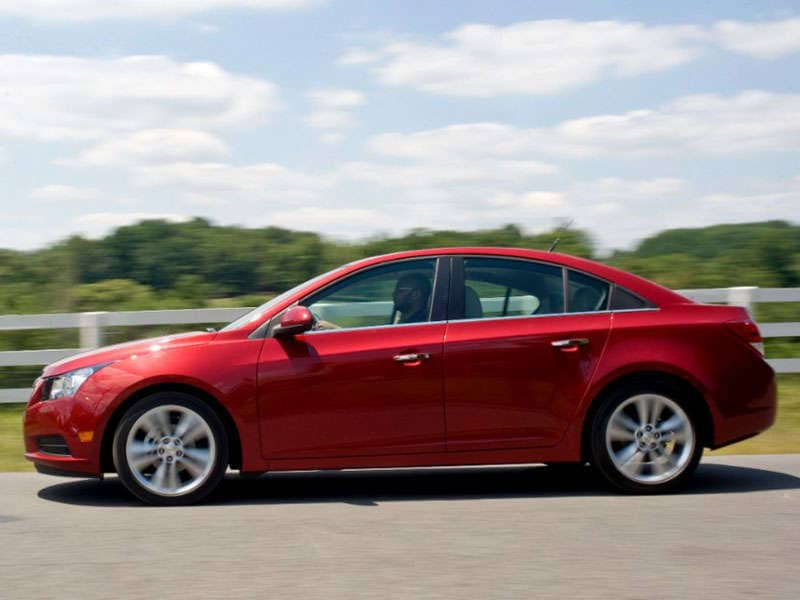
2014 Chevrolet Cruze: Comfort and Cargo
Selecting the Cruze 2LT means you get a 6-way power-adjustable driver’s seat, and it’s really easy to get comfortable behind the Cruze’s tilt/telescopic steering wheel, which is wrapped in smooth, quality leather and is pleasing to grip. I covered 450 miles in a day, and found little reason to complain about comfort.
Better yet, my passenger was also comfortable, thanks to the manual height adjuster for the front passenger’s seat, which ensures that whomever is riding shotgun can sit somewhere other than on the floor. This simple and thoughtful inclusion instantly makes the Cruze a more viable candidate than many competitors, both in the compact and midsize car classes.
Where potential buyers might decide to put a big, black “X” through the Cruze’s name on the consideration list is with regard to rear seat space. This car’s back seat is comfortable in and of itself, but legroom is super tight, and because of how the space is configured, the upper part of the front seatback is right in your face, similar to what happens when the jerk in front you suddenly reclines a coach-class airline seat.
To some degree, the Cruze makes up for this shortcoming with its 15 cu.-ft. trunk, giving it as much cargo space as some midsize sedans. Still, I’d rather have more rear-seat room and less trunk room.
Image does not depict MyLink infotainment system
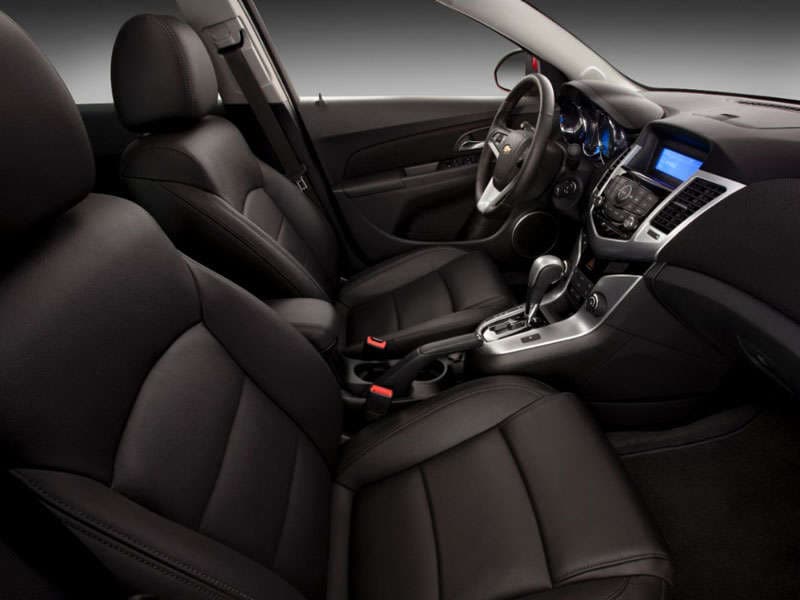
2014 Chevrolet Cruze: Features and Controls
The more I drove the Cruze, the more I liked it, and a big reason has to do with the car’s interior. Aside from impressive comfort levels – for front seat occupants, anyway – this is a remarkably quiet car when underway. Plus, the controls are logically laid out and easy to use, and the MyLink infotainment system’s graphics are clean and appealing, all of which helps to make this car great for piling on the miles.
But like most things in life, the Cruze isn’t perfect. For example, I found it hard to access the radio station pre-set buttons on the MyLink screen. In order to ensure success every time, I had to turn my hand upside down and use my pinky finger to get the touch-sensitive buttons to respond consistently.
I also had a problem with the small storage slot located just forward of the shifter, which is seemingly sized and shaped for holding a smartphone. Unfortunately, when I placed my smartphone there, I couldn’t shift the car into Park. My very first time trying this, the car went into Reverse when I thought I had selected Park, and I discovered the error only when I released my foot from the brake and the Cruze started rolling backwards.
Speaking of rolling backwards, a reversing camera is a $380 option on the 2LT model, bundled in a package containing heated side mirrors and an auto-dimming rearview mirror. During my time with the Cruze, I wanted all three of these features, so I highly recommend upgrading.
The Cruze’s cupholders are hard to use because they’re mounted too far back on the center console. Plus, if you take advantage of the sliding center console armrest, it blocks one of the two cupholders. Chevy says it is revising the cupholder design with the arrival of the 2015 Cruze.
Finally, during a longer trip on the freeway, my right foot suffered fatigue because the Cruze’s pedals are mounted a little too close to the driver, even when the driver’s seat is moved all the way back in its generous track. Good thing this Cruze had cruise.
Image does not depict MyLink infotainment system

2014 Chevrolet Cruze: Safety Matters
OnStar telematics technology is standard equipment for every 2014 Cruze, and includes a free 6-month trial subscription to a package of services that includes Automatic Crash Response. With an active subscription to service, Automatic Crash Response activates if the airbags deploy, contacting emergency services personnel in order to speed rescuers to the scene of a collision.
In addition to OnStar, the Cruze is available with several optional safety features including a reversing camera and an Enhanced Safety Package containing rear parking assist sensors, a Side Blind Zone Alert system, and a Rear Cross Traffic Alert system.
In crash tests conducted by the National Highway Traffic Safety Administration (NHTSA), the Cruze earns an overall rating of 5 stars. That’s great, but the Cruze is not eligible for a “Top Safety Pick” rating from the Insurance Institute for Highway Safety (IIHS) because it receives a “Marginal” rating in the small overlap frontal-impact test.

2014 Chevrolet Cruze: Driving Impressions
Most Chevy Cruze models are equipped with the same turbocharged, 1.4-liter 4-cylinder engine installed in my 2LT test car. It makes 138 horsepower at 4,900 rpm, and 148 lb.-ft. of torque starting at just 1,850 rpm. This represents an improvement over the base Cruze LS model’s 1.8-liter 4-cylinder engine, which generates 138 horsepower at 6,300 rpm and 125 lb.-ft. of torque at 3,800 rpm, and which also carries a lower EPA fuel economy rating.
Blah, blah, blah…what does this mean to you? Because the turbocharged engine makes its power at lower rpm, and makes more torque across a broader rev range, the end result is a vehicle that feels more energetic, especially at low to mid-range speeds, while also getting better gas mileage.
A 6-speed manual gearbox is standard with 1LT, Eco, and 2LT trim levels, but my test car had the optional 6-speed automatic, which offers a Sport driving mode and a manual shift gate to the right of the main gear path. If you shift gears for yourself, you’ll push the selector forward (or up) for an upshift, and pull it back (or down) for a downshift. This is an intuitive arrangement, but I didn’t find a need for it, and I didn’t discern much of a difference in terms of responsiveness when the transmission was placed in Sport mode.
According to the EPA, my Cruze 2LT should have returned 26 mpg in the city and 38 mpg on the highway, for a rating of 30 mpg in combined driving. While my car’s engine was still green, it averaged 31.4 mpg over 625 miles of driving, the majority of which were covered on freeways. As usual, it appears that either Chevrolet or the EPA have overstated fuel economy estimates for the Cruze.
Around town, aside from the characteristic turbo lag right when you press on the gas, the Cruze’s turbocharged engine feels energetic enough for normal driving. If you’re the type that likes to go fast and have fun, this little 1.4-liter turbo is going to disappoint, as it feels just as quick at part throttle as it does at full throttle.
Out on the highway, my Cruze definitely lacked passing power. Punching the gas at 65 mph to get around slower moving traffic, the Cruze proved gutless, and that was on a level stretch of highway with two people aboard and an empty trunk. I’d hate to try to pass traffic on a hill, or with a full house.
Generally speaking, the Cruze’s electric steering is pleasing. Rarely did I feel unnatural oscillations or disconnectedness on center, and when these traits were evident they were subtle rather than dramatic. Overall, the steering feels natural throughout its range of motion and responds as the driver might expect of a mainstream compact car: not too fast, not too slow, but just right.
When you upgrade to a Cruze 2LT, you get bigger 17-inch wheels and tires, a sport-tuned suspension, and 4-wheel-disc brakes that replace the standard front-disc/rear drum setup on the LS, 1LT, and Eco models. For these three reasons, I strongly urge buyers to consider the 2LT, and not just because the aluminum wheels are good looking.
The stouter stoppers are easy to modulate and quick to respond to input, instilling confidence in the Cruze 2LT’s driver, while the sport suspension proves taut and firm without exhibiting brittleness. The ride isn’t soft and absorptive, but neither is it harsh or uncomfortable. As a result, the Cruze feels more athletic than it is.
Perhaps most remarkable, though, is that the Cruze’s simple semi-independent compound crank rear suspension never felt skittish on rough surfaces, and never broke loose due to impacts. The roads around Boston and Massachusetts took a beating last winter, yet the Cruze remained firmly planted to the pavement at all time, tackling the cracks, scars, fissures, and holes in the road with ease.
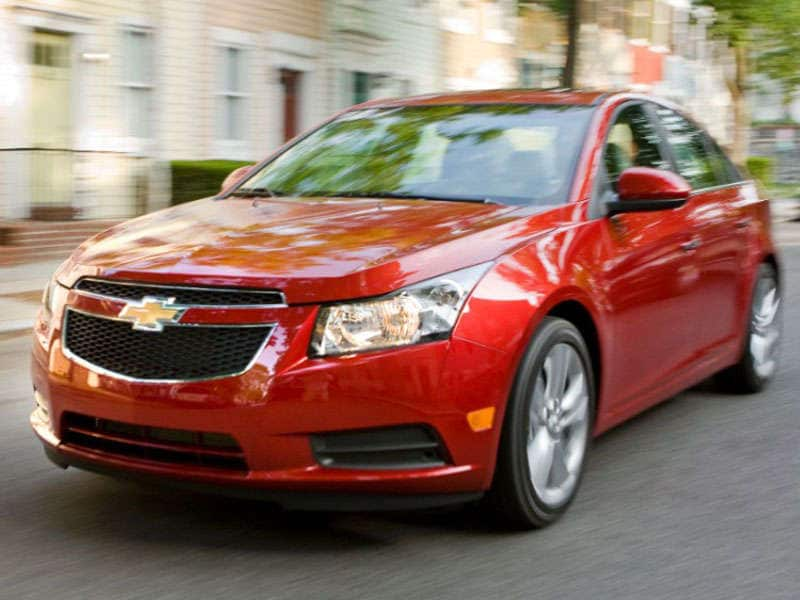
2014 Chevrolet Cruze: Final Thoughts
Chevrolet hasn’t made many changes to the Cruze since it debuted for the 2011 model year, and the car has aged remarkably well, remaining competitive in many ways. There are a few things to fix, but based on the minor refresh coming for the 2015 model year, it would appear that few of my complaints are addressed. Given the lack of substantive change in the refreshed 2015 Cruze, I think the car remains worthy of consideration, but there are better choices in the compact sedan segment.
The author rented this vehicle from Enterprise Rent-A-Car
2014 Chevrolet Cruze photos courtesy of General Motors
